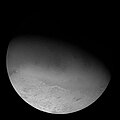 Kraken Catena and nearby Set Catena, highlighted with arrows. The two pit chains are aligned radially from nearby Leviathan Patera | |
| Feature type | Crater chain, tectonic rift |
|---|---|
| Location | Monad Regio, Triton |
| Coordinates | 14°00′N35°30′E / 14.00°N 35.50°E [1] |
| Discoverer | Voyager 2 |
| Eponym | Kraken |
Kraken Catena is a pit chain (catena) and likely tectonic fault [2] on Triton, the largest natural satellite of Neptune. It, along with Set Catena, is located near and is aligned approximately radially from Leviathan Patera, a major cryovolcanic feature; as such, Kraken Catena may have played a role in rift-induced cryovolcanic activity in Leviathan Patera. [2] [3] Several of Kraken Catena's pits have central steep-sided knobs, giving a moated appearance similar to the moated mountains found on Pluto's moon Charon and Uranus's moon Ariel. [3]
As with all other surface features of Triton, Kraken Catena was discovered when Voyager 2 visited the Neptune system on 25 August 1989. It is named after the Kraken of Norse mythology; the name was officially approved by the International Astronomical Union (IAU) in 1991. It is located at 14°N, 35.5°E, within Cipango Planum and Monad Regio. [1]
